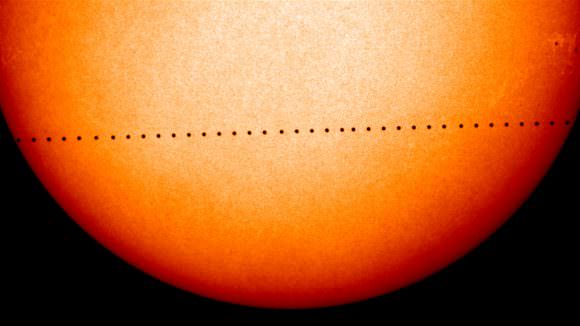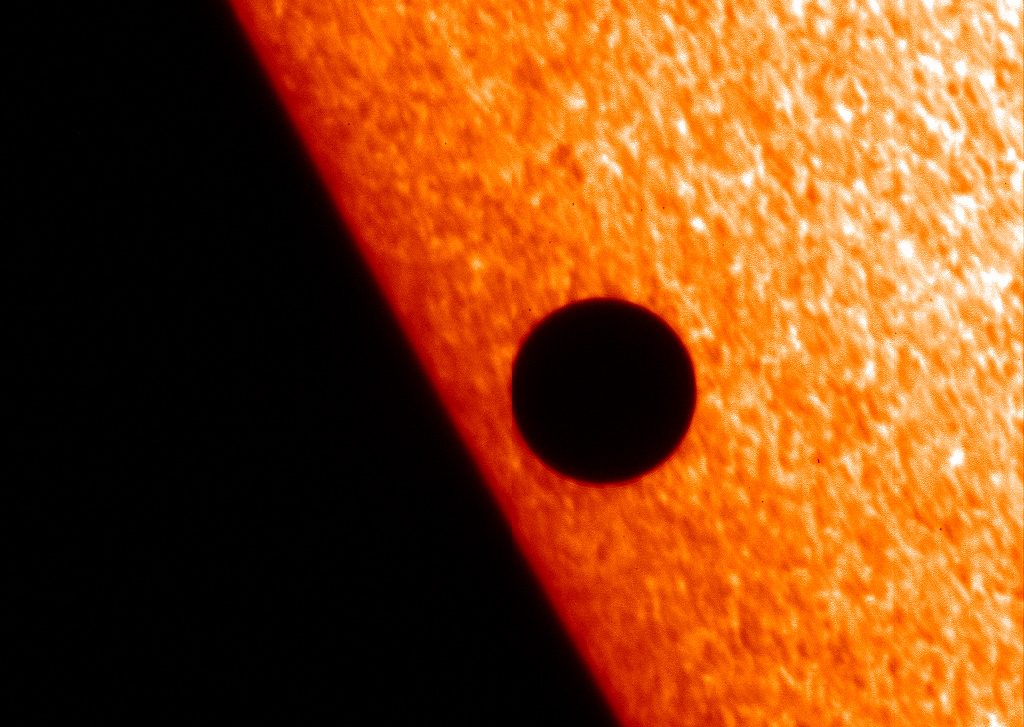Mercury is famously known for being a scorching hot world. On the side that is facing towards the Sun, conditions can get pretty molten, reaching temperatures of up to 700 K (427 °C; 800°F) in the equatorial region. The surface is also airless, in part because any atmosphere it could generate would be blown away by solar wind. Hardly surprising, considering it is the closest planet to our Sun.
But just how close is it? On average, it’s slightly more than one-third the distance between Earth and the Sun. However, its orbital eccentricity is also the greatest of any planet in the Solar System. In addition, its orbit is subject to perturbations, ones which were not fully understood until the 20th century. Because of this, Mercury goes through some serious changes during its orbital period.
Perihelion and Aphelion:
Mercury orbits the Sun at an average distance (semi-major axis) of 0.387 AU (57,909,050 km; 35,983,015 mi). However, due to its eccentricity of 0.205 – the highest in the Solar System, with the exception of Pluto (0.248) – its distance from the Sun ranges considerably. When it is at its closest (perihelion), it is 46,001,200 km (28,583,820 mi) from the Sun; and when it is farthest away (aphelion), it is 57,909,050 km (35,983,015 mi) from the Sun.

Orbital Resonance:
At one time, scientists believed that Mercury was tidally-locked, meaning that it kept one side facing towards the Sun at all times. However, it has since been discovered that the planet actually has a slow rotational period of 58.646 days. Compared to its orbital period of 88 days, this means that Mercury has a spin-orbit resonance of 3:2. This means that the planet makes three completes rotations on its axis for every two orbits around the Sun.
Another consequences of its spin-orbit resonance is that there is a significance difference between the time it takes the planet to rotate once on its axis (a sidereal day) and the time it takes for the Sun to reappear in the same place in the sky (a solar day). On Mercury, it takes a 176 days for the Sun to rise, set, and return to the same place in the sky. This means, effectively, that a single day on Mercury lasts as long as two years!
It’s slow rotation also means that temperature variations are extreme. On the Sun-facing side, temperatures can reach as high as 700 K (427 °C; 800°F) in the equatorial region and 380 K (107 °C; 224 °F) near the northern polar region. On the side facing away from the Sun, temperatures reach a low of 100 K (-173 °C; -280 °F) in the equatorial region and 80 K (-193 °C; -316 °F) near the northern polar region.

Perihelion Precession:
In addition to its eccentricity, Mercury’s perihelion is also subject to precession. What this means is, during the course of a century, Mercury’s orbit around the Sun shifts by 42.98 arcseconds (0.0119 degrees). This means that after twelve million orbits, Mercury will have performed a full excess turn around the Sun and returned to where it started.
This is much larger than the perihelion precession of other Solar planets – which range from 8.62 arcseconds (0.0024°) per century for Venus, 3.84 (0.001°) for Earth, and 1.35 (0.00037°) for Mars. Until the early 20th century, this behavior remained a mystery to astronomers, as Newtonian mechanics could not account for it. However, Einstein’s General Theory of Relativity provided an explanation, while the precession provided a test for his theory.
You might say Mercury and the Sun are pretty cozy. They dance pretty close, and the dance is powerful and full of some pretty wide swings!
We have written many interesting articles about the distance of the planets from the Sun here at Universe Today. Here’s How Far Are the Planets from the Sun?, How Far is Venus from the Sun?, How Far is Mars from the Sun?, How Far is the Earth from the Sun?, How Far is the Moon from the Sun?, How Far is Jupiter from the Sun?, How Far is Saturn from the Sun?, How Far is Uranus from the Sun?, How Far is Neptune from the Sun? and How Far is Pluto from the Sun?
If you’d like more info on Mercury, check out NASA’s Solar System Exploration Guide, and here’s a link to NASA’s MESSENGER Misson Page.
We’ve also recorded an entire episode of Astronomy Cast all about Mercury. Listen here, Episode 49: Mercury.
Sources:


Kepler (demolish) Vs Einstein’s
Areal velocity is constant: r² ?’ =h Kepler’s Law
h = 2? a b/T; b=a? (1-?²); a = mean distance value; ? = eccentricity
r² ?’= h = S² w’
Replace r with S = r exp (? wt); h = [r² Exp (2iwt)] w’
w’ = (h/r²) exp [-2(i wt)]
w’= (h/r²) [cosine 2(wt) – ? sine 2(wt)] = (h/r²) [1- 2sine² (wt) – ? sin 2(wt)]
w’ = w'(x) + ? w'(y) ; w'(x) = (h/r²) [ 1- 2sine² (wt)]
w'(x) – (h/r²) = – 2(h/r²)sine²(wt) = – 2(h/r²)(v/c)² v/c=sine wt
(h/ r²)(Perihelion/Periastron)= [2?a.a? (1-?²)]/Ta² (1-?) ²= [2?? (1-?²)]/T (1-?) ²
? w’ = (d w/d t – h/r²] = -4? {[? (1-?²)]/T (1-?) ²} (v/c) ² radian per second
? w’ = (- 4? /T) {[? (1-?²)]/ (1-?) ²} (v/c) ² radians
? w’ = (-720/T) {[? (1-?²)]/ (1-?) ²} (v/c) ² degrees; Multiplication by 180/?
? w’ = (-720×36526/T) {[? (1-?²)]/(1-?)²} (v/c)² degrees/100 years
? w” = (-720×3600/T) {[? (1-?²)]/ (1-?) ²} (v/c) ² seconds of arc by 3600
? w” = (-720x36526x3600/T) {[? (1-?²]/(1-?)²} (v/c)² seconds of arc per century
This Kepler’s Equation solves all the problems Einstein and all physicists could not solve
The circumference of an ellipse: 2?a (1 – ?²/4 + 3/16(?²)²- –.) ? 2?a (1-?²/4); R =a (1-?²/4) v=? [G m M / (m + M) a (1-?²/4)] ? ? [GM/a (1-?²/4)]; m<<M; Solar system
Advance of Perihelion of mercury.
G=6.673×10^-11; M=2×10^30kg; m=.32×10^24kg
? = 0.206; T=88days; c = 299792.458 km/sec; a = 58.2km/sec
Calculations yields:
v =48.14km/sec; [? (1- ?²)] (1-?) ² = 1.552
? w”= (-720x36526x3600/88) x (1.552) (48.14/299792)²=43.0”/century
Conclusions: The 43″ seconds of arc of advance of perihelion of Planet Mercury (General relativity) is given by Kepler’s equation better than all of Published papers of Einstein. Kepler’s Equation can solve Einstein’s nemesis DI Her Binary stars motion and all the other dozens of stars motions posted for past 40 years on NASA website SAO/NASA as unsolved by any physics
Anyone dare to prove me wrong?
No one cares, I’m glad you know how to cut and paste math equations. But if you are such a genius why are you not working for JPL?
How can the average distance from the sun 35,983,015 miles be the same as it’s farthest point from the sun? 35,983,015 miles. Basic math tells us the average distance should be 32,283,417.5 miles from the sun. (35,983,015 + 28,583,820) / 2 = 32,283,417.5